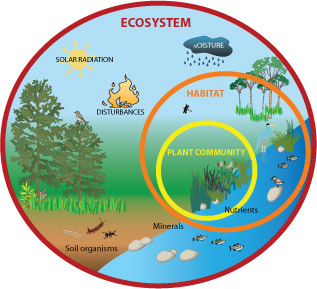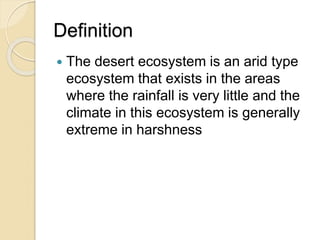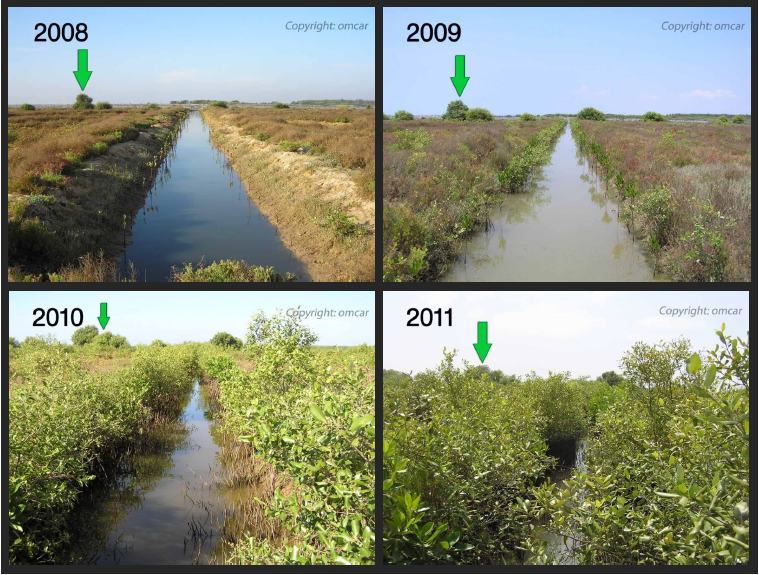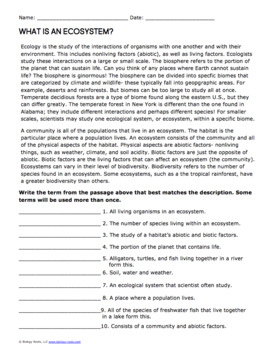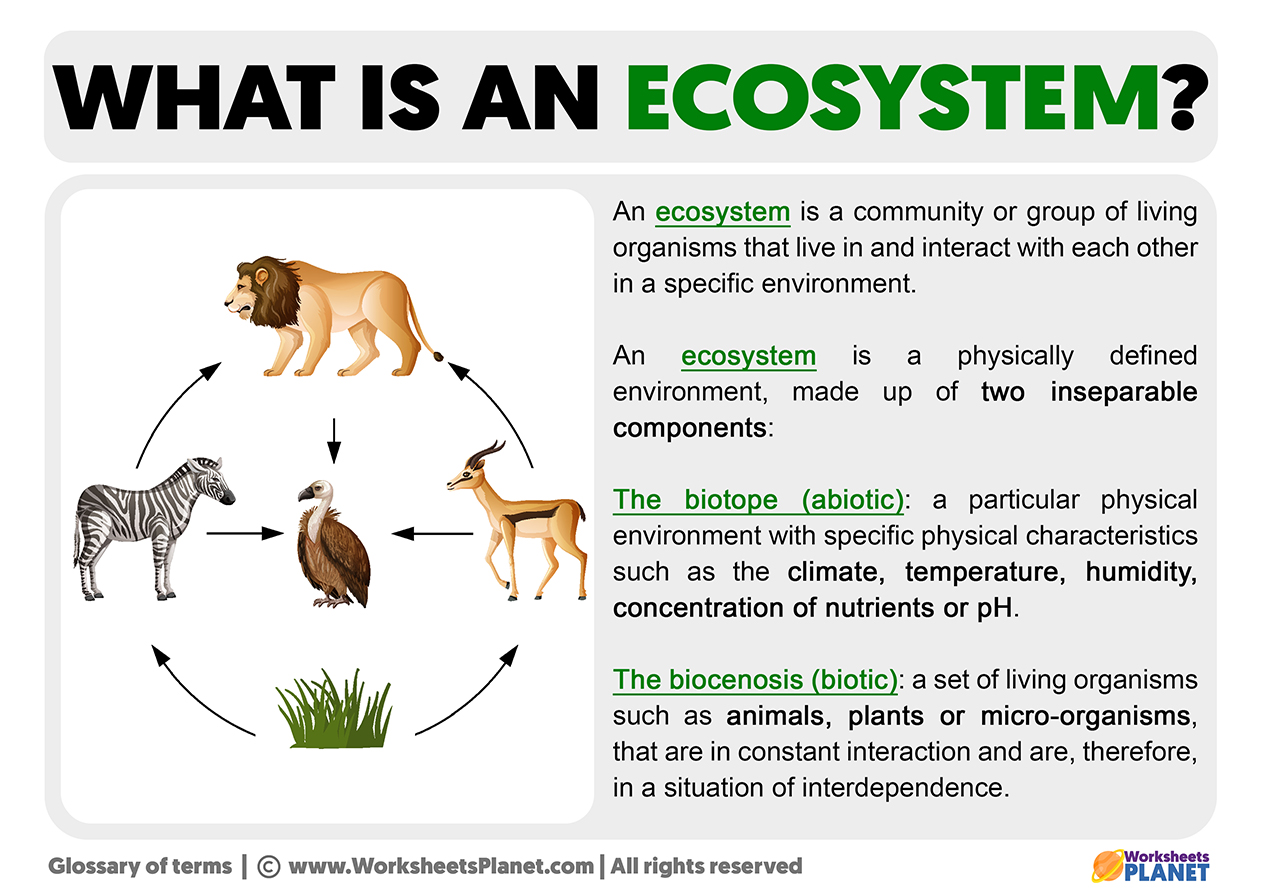Topic define ecosystem in science: Discover the essence of ecosystems in science, a fascinating exploration into the interconnectedness of life and the environment, shaping our world"s biological tapestry.
Table of Content
- What is the definition of ecosystem in science?
- Overview of Ecosystems
- Components of an Ecosystem
- Types of Ecosystems
- Energy Flow and Nutrient Cycles
- Importance of Ecosystems
- Threats to Ecosystems
- YOUTUBE: What is an Ecosystem? Different Types | Environmental Science | EVS | Letstute
- Conservation and Restoration
- Role of Humans in Ecosystems
- Emerging Technologies in Ecosystem Science
What is the definition of ecosystem in science?
An ecosystem, in the field of science, refers to a biological community of interacting organisms and their physical environment. This includes all living organisms within a specific area, such as plants, animals, and microorganisms, as well as the abiotic factors like soil, water, air, and sunlight that influence their behavior and survival.
- An ecosystem can be as small as a pond or as large as a forest, with each component playing a vital role in maintaining the balance and sustainability of the system.
- Interactions within an ecosystem are complex and intricate, with organisms depending on each other for resources and energy in a delicate web of relationships.
- Humans are also part of ecosystems and can significantly impact their health and stability through activities like deforestation, pollution, and habitat destruction.
Overall, understanding ecosystems is crucial in ecological studies as they provide insights into the intricate connections between living organisms and their environment, highlighting the importance of conservation and sustainable practices.
READ MORE:
Overview of Ecosystems
An ecosystem in science is defined as a dynamic complex of plant, animal, and microorganism communities and their non-living environment interacting as a functional unit. This fundamental concept helps us understand the intricate connections that sustain life on Earth. Ecosystems vary widely in size and composition, encompassing everything from small ponds to vast forests and oceans.
- Biological Components: Include all living organisms within the ecosystem, categorized into producers, consumers, and decomposers.
- Physical Components: Consist of non-living elements like climate, water, minerals, and sunlight, which support the biological components.
- Interactions: Ecosystems are characterized by the energy flow and nutrient cycles that maintain their balance and functionality.
Ecosystems are not isolated and can be affected by external factors such as climate change, pollution, and human activities. Understanding ecosystems and their dynamics is crucial for conservation efforts and sustainable management practices.

Components of an Ecosystem
Ecosystems are composed of biotic (living) and abiotic (non-living) components that interact in complex ways. These components work together to sustain the ecosystem"s health and productivity.
- Biotic Components: These include all living organisms within the ecosystem, divided into three main groups:
- Producers (Autotrophs): Organisms that produce their own food through photosynthesis or chemosynthesis, such as plants and algae.
- Consumers (Heterotrophs): Organisms that cannot produce their own food and rely on other organisms for nutrition. Consumers are further classified as herbivores, carnivores, omnivores, and detritivores.
- Decomposers: Organisms like bacteria and fungi that break down dead organisms, returning nutrients to the soil and completing the nutrient cycle.
- Abiotic Components: These are the non-living physical and chemical aspects of the ecosystem, which include:
- Water: Essential for all living organisms, acting as a medium for biological processes.
- Soil: Supports plant life and houses many organisms; composed of minerals, organic matter, air, and water.
- Air: Provides oxygen for respiration and carbon dioxide for photosynthesis.
- Sunlight: The primary energy source for photosynthesis in plants.
- Temperature: Influences the metabolic rates of organisms and the distribution of ecosystems.
Understanding the components of an ecosystem and their interactions is vital for studying ecological balance and the impact of human activities on natural environments.
Types of Ecosystems
Ecosystems are broadly categorized into two main types: terrestrial and aquatic. Each type encompasses a variety of ecosystems with unique characteristics, organisms, and environmental conditions.
- Terrestrial Ecosystems: These ecosystems are found on land and are categorized based on climate, vegetation, and geography. Common types include:
- Forests: Diverse in species, they can be tropical, temperate, or boreal (taiga), characterized by dense trees and a wide variety of flora and fauna.
- Deserts: Defined by their dry conditions, sparse vegetation, and adaptations of organisms to conserve water.
- Grasslands: Dominated by grasses, they can be tropical savannas or temperate grasslands, supporting a variety of herbivores and predators.
- Tundra: Characterized by cold temperatures, permafrost, and minimal vegetation, it supports hardy species adapted to extreme conditions.
- Aquatic Ecosystems: These ecosystems are based in water environments and are divided into freshwater and marine ecosystems.
- Freshwater Ecosystems: Including rivers, lakes, streams, and wetlands, these ecosystems are crucial for the water cycle and biodiversity.
- Marine Ecosystems: Covering oceans, seas, coral reefs, and estuaries, they are home to a vast array of life and are influenced by saltwater.
Each ecosystem type plays a vital role in the biosphere, contributing to biodiversity, climate regulation, and providing services essential for life on Earth.
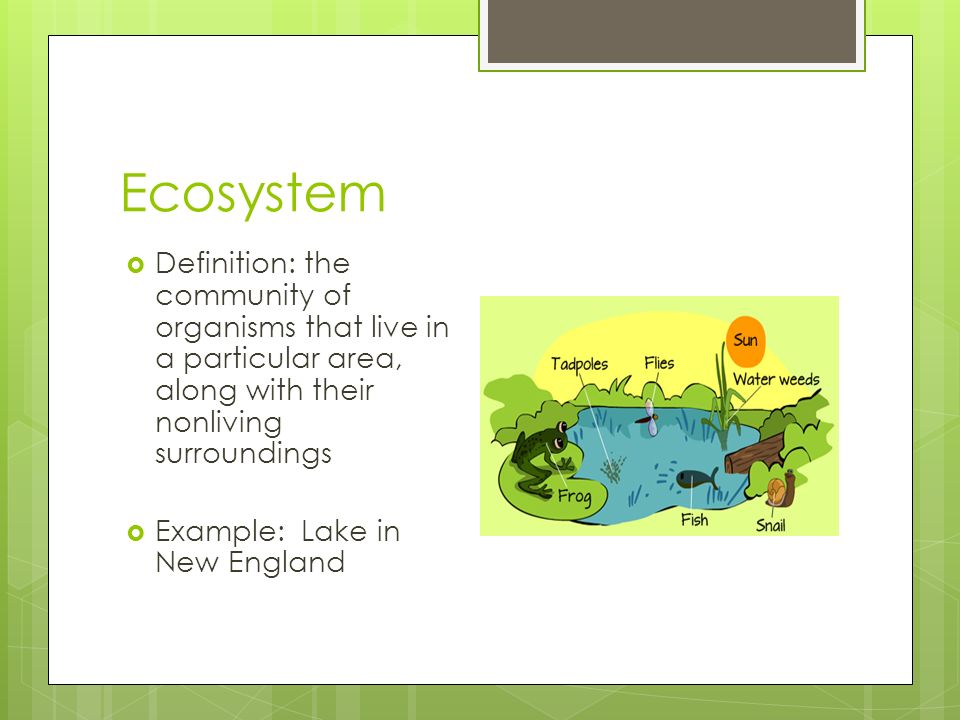
Energy Flow and Nutrient Cycles
The sustainability of ecosystems relies on the continuous flow of energy and recycling of nutrients. These processes ensure that ecosystems can function and support life over time.
- Energy Flow: Energy in ecosystems flows in a linear direction, from the sun to producers and then through various levels of consumers. This flow can be illustrated by food chains and food webs, showing the relationships between producers, consumers, and decomposers. Energy is lost as heat at each trophic level, explaining why there are fewer top predators in an ecosystem than producers.
- Nutrient Cycles: Unlike energy, nutrients are recycled within ecosystems. Key nutrient cycles include the carbon, nitrogen, phosphorus, and water cycles. These cycles involve the movement of nutrients from the physical environment to living organisms and back, maintaining ecosystem health and productivity.
- Carbon Cycle: Involves the exchange of carbon among the biosphere, pedosphere, geosphere, hydrosphere, and atmosphere of the Earth.
- Nitrogen Cycle: Describes the movement of nitrogen between the atmosphere, soil, and organisms, crucial for synthesizing proteins and nucleic acids.
- Phosphorus Cycle: Moves phosphorus through the lithosphere, hydrosphere, and biosphere, essential for cell function and growth.
- Water Cycle: Describes the continuous movement of water on, above, and below the surface of the Earth, crucial for all life forms.
Understanding energy flow and nutrient cycles is essential for grasping how ecosystems function, their resilience, and how human activities impact natural processes.
Importance of Ecosystems
Ecosystems are vital for the survival and well-being of all living organisms on Earth. They provide essential services that support life, drive economic activities, and maintain environmental balance.
- Biodiversity Support: Ecosystems are home to a vast array of species, contributing to biodiversity. This diversity is crucial for resilience and adaptability to changes and disturbances.
- Natural Services: They offer countless services, including air and water purification, climate regulation, pollination of crops, and carbon sequestration, which are essential for survival.
- Resources for Humans: Ecosystems provide humans with resources such as food, raw materials, medicinal resources, and recreation opportunities, directly impacting human health and economies.
- Climate Regulation: Through processes like photosynthesis and carbon storage, ecosystems play a key role in regulating the Earth"s climate and mitigating climate change.
- Soil Formation and Protection: Ecosystems contribute to soil formation, fertility, and protection against erosion, which are essential for agriculture and natural vegetation.
The protection and sustainable management of ecosystems are critical to preserving these benefits for future generations. Recognizing the importance of ecosystems is the first step towards effective conservation and restoration efforts.

Threats to Ecosystems
Ecosystems face numerous threats that can compromise their integrity, health, and the services they provide. Addressing these threats is crucial for the preservation of biodiversity and the well-being of all species, including humans.
- Habitat Destruction: Land development, deforestation, and agriculture are leading causes of habitat loss, reducing the space available for wildlife and plant species.
- Pollution: Air, water, and soil pollution from industrial activities, agriculture, and waste disposal can degrade ecosystems and harm organisms.
- Climate Change: Rising temperatures, altered rainfall patterns, and increased frequency of extreme weather events disrupt ecosystems, affecting species distribution and abundance.
- Overexploitation: Overfishing, hunting, and harvesting at unsustainable rates deplete resources faster than they can regenerate, leading to species decline and loss.
- Invasive Species: Non-native species can outcompete, prey on, or bring diseases to native species, disrupting ecological balance.
- Chemical Threats: Pesticides, herbicides, and other chemicals can accumulate in the environment, poisoning wildlife and disrupting food chains.
Combating these threats involves concerted efforts in conservation, sustainable management practices, and global cooperation to ensure ecosystems can continue to support life on Earth.
What is an Ecosystem? Different Types | Environmental Science | EVS | Letstute
Dive into the fascinating world of ecosystems, where diverse species interact and depend on one another for survival. Witness the beauty of nature\'s balance and learn about the importance of preserving our delicate ecosystems. Watch the video to explore this interconnected web of life.
Ecosystem: Definition, Structure and Functions
Unravel the enigmatic concept of \"definition\" and discover the power of language in shaping our understanding of the world. Join us on a journey of discovery and enlightenment as we explore the complexities of defining ideas. Watch the video to expand your knowledge and broaden your horizons.
Conservation and Restoration
Conservation and restoration efforts are essential to protect ecosystems and their biodiversity, ensuring their services are preserved for future generations. These practices aim to maintain natural habitats, restore degraded areas, and safeguard species from extinction.
- Protected Areas: Establishing national parks, reserves, and wildlife sanctuaries helps protect habitats and provides sanctuaries for species to thrive.
- Restoration Projects: Activities such as reforestation, wetland restoration, and coral reef rehabilitation aim to restore ecosystems to their natural state.
- Sustainable Practices: Promoting sustainable agriculture, fishing, and forestry practices reduces the impact on ecosystems and supports biodiversity.
- Legislation and Policies: Enacting and enforcing laws related to environmental protection, wildlife conservation, and pollution reduction helps safeguard ecosystems.
- Community Involvement: Engaging local communities in conservation efforts ensures the sustainable management of natural resources and raises awareness of environmental issues.
- Research and Monitoring: Ongoing scientific research and monitoring of ecosystems help identify changes, threats, and the effectiveness of conservation strategies.
By combining these approaches, we can address the threats to ecosystems, restore their health and functionality, and ensure their benefits are available for the long term.

Role of Humans in Ecosystems
Humans play a unique and profound role in ecosystems, acting as both stewards and disruptors of the environment. Our activities have far-reaching effects on the ecological balance, highlighting the importance of responsible interaction with the natural world.
- Impact on Biodiversity: Human activities, such as habitat destruction, pollution, and climate change, significantly impact biodiversity, leading to species extinction and loss of habitat.
- Resource Utilization: Humans depend on ecosystems for resources like food, water, and materials, necessitating sustainable practices to ensure these resources remain available.
- Environmental Management: Through conservation efforts, policy-making, and sustainable development, humans have the capacity to manage and protect ecosystems, ensuring their health and resilience.
- Science and Research: Human curiosity and ingenuity drive scientific research, enhancing our understanding of ecosystems and how to effectively conserve them.
- Education and Awareness: Educating the public about the importance of ecosystems and how to protect them is crucial for fostering a culture of conservation and respect for the environment.
The role of humans in ecosystems is pivotal. By adopting sustainable practices, supporting conservation efforts, and increasing our understanding of ecological processes, we can ensure the health and longevity of the planet"s ecosystems for future generations.
READ MORE:
Emerging Technologies in Ecosystem Science
Advancements in technology are revolutionizing the field of ecosystem science, offering new insights and tools for understanding, monitoring, and preserving ecosystems. These technologies are enhancing our ability to study complex ecological processes in unprecedented detail.
- Remote Sensing: Satellites and drones are used for large-scale monitoring of ecosystems, tracking changes in vegetation, land use, and effects of climate change from a distance.
- GIS and Mapping: Geographic Information Systems (GIS) enable the analysis and visualization of environmental data, improving our understanding of spatial patterns and relationships in ecosystems.
- Environmental DNA (eDNA): Analyzing DNA found in the environment allows for non-invasive monitoring of biodiversity, helping to detect species presence and abundance without direct observation.
- Machine Learning and AI: Artificial intelligence and machine learning algorithms are used to process large datasets, predict ecological outcomes, and model ecosystem responses to various scenarios.
- Biotelemetry and Tracking: The use of electronic tracking devices on animals provides insights into migration patterns, habitat use, and interactions within ecosystems.
- Citizen Science: Leveraging the power of citizen scientists through mobile apps and online platforms expands data collection efforts and engages the public in scientific research.
These emerging technologies are crucial for advancing our understanding of ecosystems, enabling more effective conservation strategies, and fostering a deeper connection between humans and the natural world.
Exploring the vastness of ecosystems unveils the interconnectedness of life and its habitats, urging us to appreciate, protect, and sustain the delicate balance that nurtures biodiversity and secures our planet"s future.
